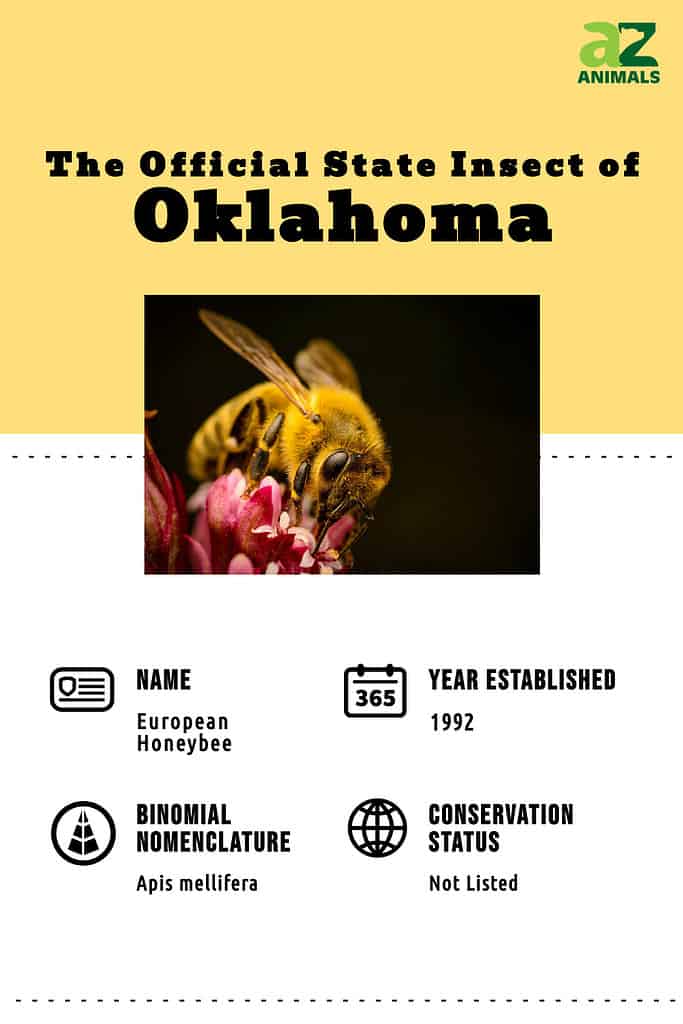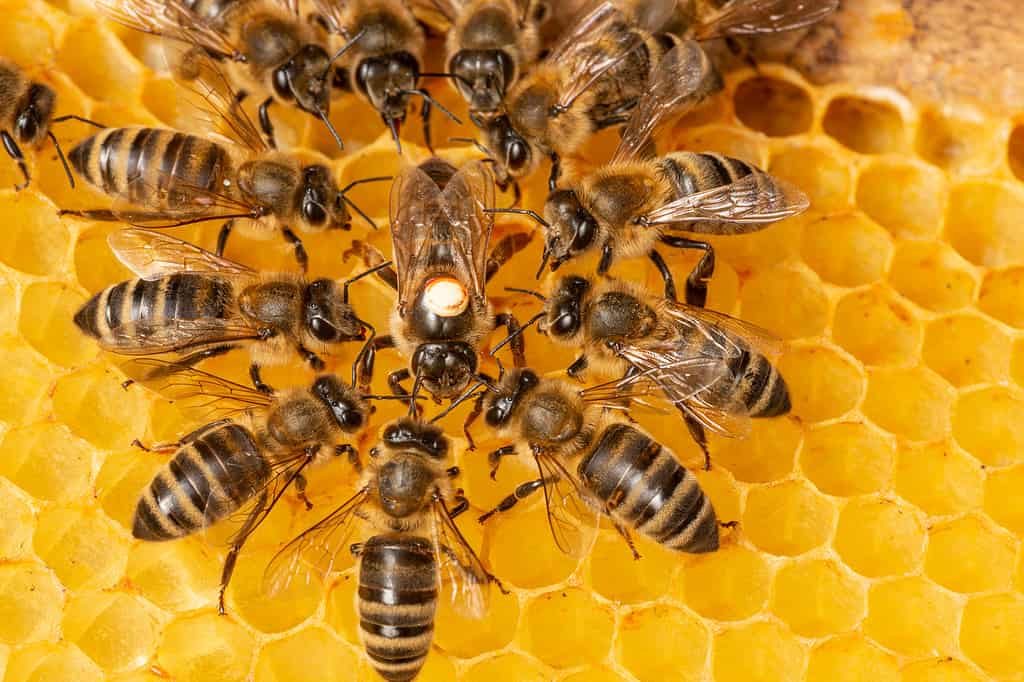In 1992, state legislators designated the European honeybee as the Oklahoma state insect. Because of its important role in agricultural pollination and contribution to the global food supply, 16 other states have chosen this honeybee as their state insect as well.
As important as these insects are to humanity, however, their populations are in decline all over the country. While many of the causes are easily identifiable, some, like the strange colony collapse disorder, are difficult to pin down.
In this article, we’ll put the spotlight on the European honeybee, taking a look at the reasons it became the Oklahoma state insect. We’ll also look at how these bees live, where they came from, and how they affect their environment.

About the European Honeybee
The European honeybee was likely the first insect ever domesticated. Since its domestication, people have relied on this species of honeybee for its pollination and hive products. From beeswax to honey and royal jelly, these insects have offered humanity much more than just their skills as pollinators. Below, we’ll take a look at the special biology and life cycle of this important insect.
Size and Appearance
European honeybees are pretty easy to identify if you can get a good look. They have hairy bodies and iconic yellow-and-black banded abdomens. They also have two sets of wings and antennae that are longer than their heads. While they are all nearly identical, however, these bees exhibit some important differences in appearance depending on their role in the hive.
The smallest bees of any given hive are its workers. They use their hind for bulk pollen collection, and each one has a specialized collection structure called a corbicula. Additionally, workers produce a waxy substance on the underside of their abdomens which they then use to build the hive.
Male bees, called drones, are the largest members of the hive. They are usually about three-quarters of an inch in length and have eyes that more closely resemble those of flies. When it is time to reproduce, these males congregate to mate with new queens from different hives.
The queen bee, who spends most of her life in the hive, very closely resembles a worker bee. Although her head and thorax are about the same size as those of a worker bee, her abdomen is considerably larger and rounder. The queen’s stinger is unique as well — the barbs are much smaller than those of a worker, allowing her to sting multiple times without harm. When a worker bee stings, her stinger tears from her abdomen, which results in her death.

A
queen European honeybee surrounded by worker bees
— note the similarities in appearance. Oftentimes, beekeepers will mark the queen with a dab of paint so that she is easier to locate among the hive’s many workers.
©Kuttelvaserova Stuchelova/Shutterstock.com
Life Cycle
The hives of the European honeybee are started and managed by a queen bee, who is the only reproducing female in the entire colony. She can produce up to 1500 eggs in a single day. Each egg is very small, measuring only about a millimeter in length on average. Within three days, the eggs hatch and give way to newly born larvae which begin their metamorphic journey to adulthood.
Larval Stage
Honeybees spend varying lengths of time in their larval stage depending on their future role within the colony. These roles, referred to as castes, are chosen genetically and dietarily. Eggs that the queen does not fertilize develop into male bees, called drones. Those eggs that she does choose to fertilize develop into female bees that can become either workers or queens. Which one a larva becomes depends on the care it receives from the hive. Larvae that receive a standard diet become worker bees, which perform all of the care and maintenance tasks for the hive. Those that receive a special diet of royal jelly develop the quickest and eventually become queens.
Pupal Stage
The next stage in the bee’s lifecycle, the pupal stage, occurs when the larva is ready for its first molt. At this stage, the adult workers seal the opening of the larval cell with a wax cap that protects the new bee until it emerges as an adult. Future workers will remain in this stage for about 12 days. Queens will emerge in around 8 days. Drones take the longest, emerging as adults after about two full weeks.
Adulthood
Once the pupal stage ends, the newly matured bee will chew through the wax cap of its cell. At this point, it is fully ready to carry out its vital tasks. The youngest worker bees, those that have just emerged, begin caring for the next generation of workers. As they age, their responsibilities change. Older workers will construct wax combs inside of the hive and handle the food supply. The oldest worker bees in the hive venture out to collect pollen and bring it back to the hive.
Usually once per year, a hive will begin to raise between 10 and 20 new queens. Once the hive has raised them past their larval stage, the original queen and most of the workers will depart from the hive in search of a new home. The departed bees will form a large dense group, called a swarm, somewhere nearby and send scouts in search of a location to build a new hive.
In the old hive, newly emerging queens will fight each other until a single one remains. When the winner has been decided, she will venture out from the hive to mate with over a dozen male drones from other hives, whose sperm she stores for the rest of her life. This ensures genetic diversity within the new hive. After she has mated, the new queen begins her own colony and the life cycle begins again.
Ecological Role and Impact of the European Honeybee
The European honeybee, as you might assume from its name, is not native to the Americas. It was domesticated in its native European range and was then carried around the world by colonists from various European countries. Overall, its most crucial ecological role is much the same as most other bees — it pollinates.
During their food-foraging activities, worker bees become covered in pollen. As they travel around from flower to flower in search of pollen and nectar, some of the collected pollen rubs off on the flower’s reproductive parts. This pollen transfer fertilizes the flower and allows the plant to reproduce.
Because European honeybees are such prolific pollinators, some beekeepers make their livings transporting entire hives of them around the country. The transportation of bees from place to place is an important part of not only the U.S. agricultural industry but also of global food production. The European honeybee, worldwide, contributes to nearly 30% of all food production. The incredible importance to the agricultural industry is one of the main reasons that the European honeybee was named the Oklahoma state insect.

The European honeybee, although non-native, has been domesticated and used as a crucial pollinator across the world.
©SanderMeertinsPhotography/Shutterstock.com
Disruption of Native Bee Species
Because it is such an integral part of agricultural practices across the United States, the European honeybee exists across the country in large numbers. This has some negative consequences, however. Evidence suggests that, because of the number of colonies needed to sustain crop production, these bees are competing for food with many native bee species.
Although there are other factors at play, the decreased forage available for native bees as well as the increased spread of bee diseases and pests are contributing to their decline. Parasitic organisms like Varroa destructor and Crithidia species as well as deformed wing virus affect native species, like bumblebees, as well as the European honeybee. Some studies even show that wild bees with hives located near commercial apiaries are more likely to suffer from these pests and diseases. Although studies have been fairly limited, evidence suggests that commercial beekeeping may have larger, overarching negative effects on native bees and other pollinators..
Even in their native range, domesticated European honeybees may have negative effects on their wild, native counterparts. The decreased genetic diversity among domesticated colonies, caused by artificial selection, threatens the survival of wild members of the same species. As wild and domesticated colonies interbreed in disproportionate numbers, wild bees may become even more susceptible to the deadly viruses and parasites that wreak havoc in commercial colonies.

A native rusty-patched
bumblebee
. Increased human development and climate change are contributing to their shrinking numbers. Competition with the European honeybee is likely also a contributing factor.
©Taxomony/Shutterstock.com
The photo featured at the top of this post is © Daniel Prudek/Shutterstock.com
Thank you for reading! Have some feedback for us? Contact the AZ Animals editorial team.






